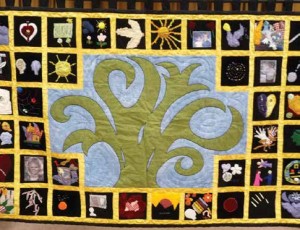Bonnie Weppler
There is a most unique quilt hidden away in two large suitcases in office L353 at Saint Paul University.
The Justice Storytelling Quilt hosts 27English-language quilt blocks and 13 French-language; each one was created by a victim of crime, an offender or a family member, and the blocks represent their stories.
With funding from the Women’s Inter-Church Council of Canada, the quilt will soon be much more accessible. An interactive online version of the quilt was expected to be available by the middle of May. Use https://ccjc.ca/current-projects/ to access the online quilt.
With the aid of a computer, a click on any of the blocks allows participants to listen to the person tell his/her story while looking at the block on the actual quilt. The stories are heartbreaking and sometimes extremely difficult to listen to: a wife whose husband unsuccessfully attempted to kill her; a man who intended to commit a robbery but instead ended up murdering someone; a woman who expresses empathy for the teen who killed her husband; a man who shares his pain after a drunk driver kills his father; a step-daughter whose step-father sexually abused her from the time she was four years old.
The idea for the creation of the original Justice Storytelling Quilt came from Lorraine Berzins, former Executive Director of The Church Council on Justice and Corrections(CCJC). Berzins was inspired by another interactive story quilt, First Kissed, by artist Meaghan O’Shea.

Now available with online stories from crime victims, offenders and family members, the quilt was designed to bring people together to empathize with the suffering, hope and courage embodied in each of the quilt’s 40 blocks. Supplied Photo
The purpose of The Justice Storytelling Quilt is ultimately an attempt to humanize justice: by hearing people speak from their hearts about what they have been through and what they need to help them recover.
Creating the quilt, and their individual blocks, helped these victims, offenders and family members to find understanding and meaning. It reassures them that life can still be good and worth living, despite the suffering and horror they have been through. Ultimately, the quilt was designed to bring people together to empathize with the suffering, hope and courage of victims, offenders and family members.
Some of the victims and family members met offenders through a restorative justice program which allowed them to get answers to questions they had, and which is not usually possible in a criminal justice process. It also helped them to realize that a person who commits a crime is not only a criminal or a monster: he/she is a human being. Some offenders who met their victims were able to understand the impact of their behaviour on someone’s life. One of the offenders said he never realized his actions actually hurt someone until he met them.
A diverse range of materials was used in the blocks including pieces of baby quilts; photographs; a triathlon ribbon; a feather; beads. A number of the blocks contain similar images including the sun, flowers, hearts, and people.
The Justice Storytelling Quilt debuted during Restorative Justice Week 2005. During that week, the quilt was exhibited at the Ottawa Court House, Ottawa City Hall, Justice Canada and Saint Paul University. During Restorative Justice Week 2020 (November 16-22), it is hoped that the quilt can be displayed again at these four locations as part of its 15th anniversary.
The CCJC is a national faith-based coalition of eleven founding churches, created in 1974, to promote a restorative approach to justice with an emphasis on addressing the needs of victims and offenders. Through research, projects, workshops and presentations, CCJC promotes education on restorative justice and sponsors initiatives to build healthier and safer communities.
![]() To book the quilt for an event in Canada, please contact Bonnie Weppler at bweppler@ccjc.ca or 613-563-1688
To book the quilt for an event in Canada, please contact Bonnie Weppler at bweppler@ccjc.ca or 613-563-1688






